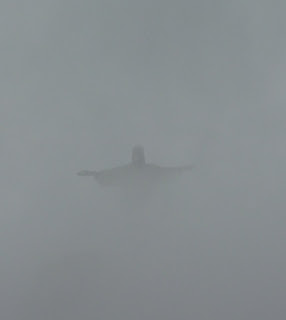We saw and identified about 160 species of birds over 11 days. The vast majority appeared in the Pantanal, which is truly a birdwatcher's paradise.
We had trouble identifying species for certain types of birds, most notably hummingbirds. So this list is probably an undercount of what we saw.
Red-legged Seriema (film makers used these guys to figure out how the velociraptors in Jurassic Park would move)
Greater Rhea
Undulated Tinamou
Chaco Chachalaca
Blue-throated Piping Guan
Black-fronted Piping Guan (Iguacu, one of the stars of the trip)
Bare-faced Curassow
Magnificent Frigatebird (Rio, phenomenal numbers)
Neotropic Cormorant
Anhinga
Southern Screamer
Muscovy Duck
Brazilian Teal
Striated Heron
Boat-billed Heron
Black-crowned Night Heron
Rufescent Tiger Heron
Cattle Egret
Great Egret
Cocoi Heron
Whistling Heron
Buff-necked Ibis
Plubeous Ibis
Green Ibis
Bare-faced Ibis
Roseate Spoonbill
Wood Stork
Maguari Stork
Jabiru (symbol of the Pantanal)
Turkey Vulure
Lesser Yellow-headed Vulture
Black Vulture
Snail Kite
Crane Hawk
Roadside Hawk
Black-collared Hawk
Great Black Hawk
Yellow-headed Caracara
Southern Crested Caracara
Gray-necked Wood Rail
Common Moorhen (Rio)
Wattled Jacana
Southern Lapwing (everywhere)
Collared Plover (Rio)
Solitary Sandpiper
Kelp Gull (Rio)
Brown Booby (Rio)
Black Skimmer
Feral Pigeon (Rio)
Eared Dove (Rio)
Picazuro Pigeon
Scaled Dove
Ruddy Ground Dove (everywhere)
White-tipped Dove
Hyacinth Macaw
Golden-collared Macaw
White-eyed Parakeet
Peach-fronted Parakeet
Monk Parakeet
Black-hooded Parakeet
Yellow-chevroned Parakeet
Blue-fronted Parrot
Perhaps others as well
Squirrel Cuckoo (Sao Paulo)
Smooth-billed Ani (North of Rio, Pantanal)
Guira Cuckoo
Ferruginous Pygmy Owl
Burrowing Owl
Great Potoo
Pauraque
White-collared Swift (Rio)
Great Dusky Swift (Iguacu)
Swallow-tailed Hummingbird (Rio, Iguacu)
Minute Hermit
Violet-capped Woodnymph
Probably other hummingbirds as well
 Black-crowned Trogon
Black-crowned Trogon
Ringed Kingfisher
Amazon Kingfisher
Green Kingfisher
Rufous-capped Motmot (Iguacu)
Rufous-tailed Jacamar (North of Rio)
Chestnut-eared Aracari
Red-breasted Toucan (Rio)
Toco Toucan (Iguacu, Pantanal; another star of the trip)
White-barred Piculet (Iguacu)
Yellow-fronted Woodpecker (Iguacu)
Little Woodpecker
Campo Flicker (Iguacu, Pantanal)
White Woodpecker
Pale-crested Woodpecker
Lineated Woodpecker
Crimson-crested Woodpecker
Olivaceous Woodcreeper
Red-billed Scythebill
Possibly other woodcreepers
Rufous Hornero
Great Antshrike
Vermillion Flycatcher
White-rumped Monjita
Cattle Tyrant
Masked Water Tyrant (Rio, North of Rio)
Great Kiskadee (everywhere)
Lesser Kiskadee
Tropical Kingbird (Rio)
Crested Black Tyrant (Rio)
Southern Beardless-Tyranulet
Short-tailed Pygmy Tyrant
Fork-tailed Flycatcher (Campo Grande)
Plush-crested Jay (Iguacu, Pantanal)
Purplish Jay
Gray-breasted Martin (Iguacu, Pantanal)
Southern Rough-winged Swallow (North of Rio)
Blue and White Swallow (Rio)
Rufous-collared Sparrow (Rio, Iguacu)
Chalk-browed Mockingbird (North of Rio, Iguacu)
Black-capped Donacobius
Southern House Wren (everywhere)
Long-billed Wren (Rio)
Thrush-like Wren
Rufous-bellied Thrush
Pale-breasted Thrush (Iguacu)
Golden-Crowned Warbler (Iguacu, Sao Paulo)
Bananaquit (Rio, Pantanal)
Chestnut-vented Conebill
Blue Dacnis (Rio, North of Rio)
Violaceous Euphonia
Sayaca Tanager
Palm Tanager
Black-goggled Tanager
Silver-beaked Tanager
Yellow-billed Tanager
Red-crested Tanager
Green-headed Tanager (North of Rio)
White-Bellied Tanager (North of Rio)
Brazilian Tanager (North of Rio)
Ruby-crowned Tanager (North of Rio)
Grayish Saltator
Tawny-bellied Seedeater
Saffron Finch
House Sparrow (Sao Paulo, Pantanal)
Screaming Cowbird
Shiny Cowbird
Giant Cowbird
Chopi Blackbird (Iguacu, Pantanal)
Unicolored Blackbird
Orange-backed Troupial
Epaulet Oriole
Golden-winged Cacique
Solitary Cacique
Red-rumped Cacique (Iguacu, Pantanal)
Yellow-rumped Cacique
Crested Oropendola









































.jpg)
).jpg)
).jpg)
